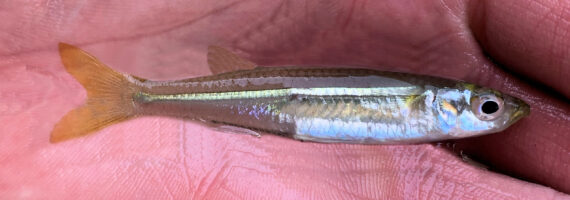Tidewater Silverside, Menidia peninsulae
 Tidewater Silverside, Menidia peninsulae. Fish caught from the Alligator Creek, Punta Gordo, Florida, March 2017. Length: 9.5 cm (3.7 inches). Catch and photograph courtesy of George Brinkman, Guelph, Ontario, Canada. Identification courtesy of Dr. Martini Arostegui, Seattle, Washington.
Tidewater Silverside, Menidia peninsulae. Fish caught from the Alligator Creek, Punta Gordo, Florida, March 2017. Length: 9.5 cm (3.7 inches). Catch and photograph courtesy of George Brinkman, Guelph, Ontario, Canada. Identification courtesy of Dr. Martini Arostegui, Seattle, Washington.
 Tidewater Silverside, Menidia peninsulae. Fish caught from the Alligator Creek, Punta Gordo, Florida, October 2020. Length: 9.5 cm (3.7 inches). Catch, photograph and identification courtesy of Luke Ovgard, Klamath Falls, Oregon.
Tidewater Silverside, Menidia peninsulae. Fish caught from the Alligator Creek, Punta Gordo, Florida, October 2020. Length: 9.5 cm (3.7 inches). Catch, photograph and identification courtesy of Luke Ovgard, Klamath Falls, Oregon.
The Tidewater Silverside, Menidia peninsulae, is a member of the New World Silverside or Atherinopsidae Family, and is known in Mexico as plateadito playero. Globally, there are ten species in the genus Menidia, of which three are found in Mexican waters, all in the Atlantic Ocean.
The Tidewater Silverside has an elongated compressed body. They are translucent and pale silvery in color and have a prominent light yellow-green lateral stripe with a black upper margin. The top of their head is dark and their belly has a yellow tinge. Their head has a short snout, large eyes, a small terminal mouth that opens in the front, and an extendible top jaw. Their anal fin has 1 spine and 11 to 19 rays; their caudal fin is large and deeply forked; their first dorsal fin has 4 to 6 spines and originates before the anus (a key to identification); their second dorsal fin has 1 spine and 7 to 12 rays and is well separated from the first dorsal fin; their pectoral fins have 15 or 16 rays; and, their pelvic fins are closer to the pectoral fins than to the anal fin. They are covered with smooth scales.
The Tidewater Silverside is a pelagic schooling species that is found in tranquil shallow intertidal waters, coastal bays, estuaries, and ponds, including brackish waters with salinities in excess of 15 ppt at depths up to 6 m (20 feet) . They reach a maximum of 18.3 cm (7.2 inches) in length. They are active daytime feeders that form large schools with juveniles consuming plankton; as they mature they change their feeding habits and consume copepods and larvae then larval fish and amphipods. Reproduction is oviparous with large masses of eggs released by females several times per year. Larvae are planktonic. The Tidewater Silverside is poorly studied with very limited information available about their lifestyle and behavioral patterns including specific details on age, growth, longevity, movement patterns, diet, habitat use, and reproduction.
The Tidewater Silverside is a resident of Mexican waters of the Atlantic Ocean but has a very limited distribution being found only along the coast of the State of Veracruz in the northwest section of the Gulf of Mexico.
The Tidewater Silverside is similar to and can be confused with the Inland Silverside, Menidia beryllina (first dorsal fin inserted directly above anus).
From a conservation perspective the Tidewater Silverside is currently considered to be of Least Concern with stable, widely distributed populations. They are small in stature and of limited interest; however, they are an important food source for a wide variety of fish, marine mammals, and sea birds.